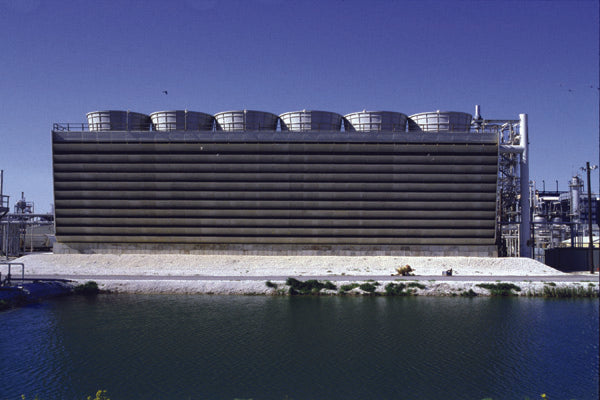Cooling Towers: Efficiency Waiting to Happen
February 12, 2018 0 Comments

Cooling towers serve the vital role of cooling water for power plant heat exchange equipment. Sustaining excellent system performance is important because a one-degree increase in water temperature can cause a 2% increase in energy usage. Proper maintenance and a few upgrades could improve a cooling tower’s efficiency, while also saving water in the process.
The smallest inefficacy in a power plant can cost a generator greatly, and many energy generators need to look no further than their aging cooling towers to find a hotbed of potential inefficacies, slowly leaching their profits. As the efficiency of a cooling tower stumbles, the temperature in the tower rises, increasing energy consumption in the unit by as much as 2% per one-degree increase. The good news is, from the fans to the nozzles, to the fill media, and even the water itself, opportunities to ramp up the efficiency of a cooling tower abound.
Film Fill for the Win
Of course, nobody intends to build an inefficient system, but many of today’s cooling towers are relics of the past, and while they may have once been state-of-the-art, they fall far behind today’s standards. One of the main areas that older plants lag behind in is fill material. Some decades-old cooling towers still in use continue to use plastic, fiberglass, or wood splash fill. This system positions splash bars to break falling water into droplets. Splash fill is better suited for crossflow towers, according to SPX Cooling Technologies Inc., because the air can easily flow horizontally through the vertical full-height fill. Newer counter-flow towers can integrate splash fill or newer film fill systems.
Around the 1980s, cooling tower efficiency efforts got a boost with the development of better performing fill media. “A breakthrough for the counterflow fills of the 1980s was the introduction of PVC film fill packs,” Terry Dwyer, director of field erected products for SPX, said. These new fill types “increase the surface area of the fill in a given cubic foot of the cooling tower, so the PVC—the plastic fill packs—increase the surface area, which increases the heat transfer.”
In fact, according to Dwyer, the easiest way to increase a cooling tower’s efficiency quickly is to change out the fill media. “We have other, higher performing fills today than we had many years ago,” Dwyer said. “It’s kind of like with a car, the fuel economy of a car today is better than it was 20 years ago. A lot of that is the engine design and technology.”
Today’s high-performance film fills boast nearly twice the thermal performance of splash fill. Film fill consists of stacks of labyrinth-like material through which the water and air flow in opposite directions. Film fill increased greatly the exposure of the water surface to the air, resulting in a much more efficient transfer of heat.
However, film fill isn’t without its disadvantages. As noted, while splash fill works to break water into droplets by—as the name suggests—making it splash off relatively wide-set bars within the tower, film fill directs the water through small funnels. Unfortunately, and unsurprisingly, most cooling towers aren’t running with filtered water. The water being used in these towers is generally pretty dirty, full of mineral and biological sediment that can easily clog the fill with microbiological growth, fouling, or scaling.
While splash fill is at a disadvantage to more modern fill styles in cooling efficiency, it’s not without its upsides. Splash fill is less dense, and thus more forgiving of difficult water. Water heavy in sediment can clog film fill far more easily than splash fill, but in general, the tradeoff is not worth it as chemical treatments to help deal with difficult water are advancing quickly.
The four main water quality issues power generators face in keeping their towers running in top shape are corrosion, scaling, fouling, and microbiological activity.
Corrosion occurs when chemicals in the water eat away at the components of the cooling tower. This can result in a loss of heat transfer, and in turn decreased efficiency. Corrosion can also lead to equipment failure, which in turn can lead to plant downtime and equipment replacement costs.
Scaling is the buildup of dissolved minerals on equipment. This too can result in the reduction of the heat exchange ability of the system as the scale can act as insulation, making it much more difficult for the system to effectively cool.
Similar to scaling, fouling is the buildup of suspended particles. While scaling is limited to minerals, however, fouling applies to anything from organic matter to oils. At best, fouling inhibits heat transfer the same way scaling does, by acting as an insulator. At worst, fouling can completely plug fill, reducing the evaporative areas of the system, dealing a blow to the efficiency of the system.
Finally, microbiological activity refers to the impact that any microorganism living in the system has on the plant. The microorganism can be suspended in the water or may grow on the surfaces of the cooling tower equipment, again resulting in reduced heat transfer due to the insulation and blockage of the fill material.
Cooling towers use massive amounts of water, so it’s no surprise that municipalities and states have in many cases delegated the lowest quality of the resources for use by power generators. In 2010, water withdrawals for thermoelectric power accounted for 45% of total withdrawals in the United States, according to the U.S. Geologic Survey’s most recent national water use report. However, water usage for thermoelectric-power generation has been on the decline (Figure 1), the report notes. Between 2005 and 2010 water withdraws in that category decreased 20%.

1. Turning tides. More efficient cooling towers reduce the amount of water withdrawn from lakes, rivers, or the ocean for thermal power plant cooling needs. Courtesy: GE Water & Process Technologies
To preserve freshwaters, some areas of the country require cooling towers to use municipal gray water or to cycle their towers more (see “Reclaimed Water Reduces Stress on Freshwater Supplies” in this issue of POWER). This was the case for a client of GE Water & Process Technologies.
“Our customers were asked to use municipal gray water. This is the wastewater from a municipal plant. When they were zoned and started up they could not use fresh water from the river or the lake, and these are very tough to treat waters,” Peter Macios, executive product manager for the company, said.
Read full article @ http://www.powermag.com/cooling-towers-efficiency-waiting-happen/?pagenum=3Also in Blog

Advanced Cooling Tower Management: Enhancing Efficiency with Lakewood Model 140
February 28, 2024 0 Comments

Optimizing Cooling Tower Performance: Understanding Efficiency, Maintenance, and Water Quality Management
February 28, 2024 0 Comments

Revolutionizing Water Analysis: Everything You Need to Know About the Kemio KEM10DIS
April 19, 2023 0 Comments

